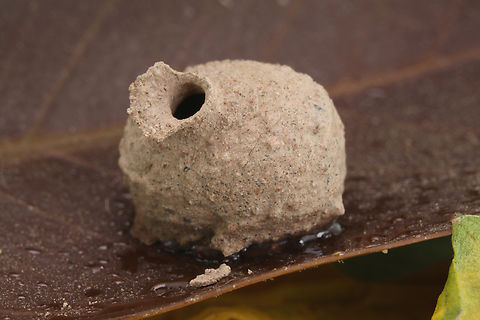![Potter Wasp nest Stuck on a leaf from an Ficus tree. single shot, 1.5X, f6.3<br />
The most widely used building material is mud made of a mixture of soil and regurgitated water, but many species use chewed plant material, instead.<br />
The name "potter wasp" derives from the shape of the mud nests built by species of Eumenes and similar genera. It is believed that Native Americans based their pottery designs upon the form of local potter wasp nests.[2]<br />
When a cell is completed, the adult wasp usually collects beetle larvae, spiders, or caterpillars and, paralyzing them, places them in the cell to serve as food for a single wasp larva. <br />
As a normal rule, the adult wasp lays a single egg in the empty cell before provisioning it. Some species lay the egg in the opening of the cell, suspended from a thread of dried fluid. When the wasp larva hatches, it drops and starts to feed upon the supplied prey for a few weeks before pupating. The complete lifecycle may last from a few weeks to more than a year from the egg until the adult emerges. Adults are black or brown, and usually marked with contrasting patterns of yellow, white, orange, red or combinations of colors. Adult potter wasps feed on floral nectar.<br />
<a href="https://en.wikipedia.org/wiki/Potter_wasp" rel="nofollow">https://en.wikipedia.org/wiki/Potter_wasp</a><br />
Delta unguiculatum,Geotagged,Great potter wasp,Summer,United States](https://s3.amazonaws.com/media.jungledragon.com/images/5803/137730_medium.JPEG?AWSAccessKeyId=05GMT0V3GWVNE7GGM1R2&Expires=1767225610&Signature=QeZm3aeY8XYB2icWlkfRDsPtcNc%3D) PromotedCountry intro
PromotedCountry intro
Potter Wasp nest
Stuck on a leaf from an Ficus tree. single shot, 1.5X, f6.3
The most widely used building material is mud made of a mixture of soil and regurgitated water, but many species use chewed plant material, instead.
The name "potter wasp" derives from the shape of the mud nests built by species of Eumenes and similar genera. It is believed that Native Americans based their pottery designs upon the form of local potter wasp nests.[2]
When a cell is completed, the adult wasp usually collects beetle larvae, spiders, or caterpillars and, paralyzing them, places them in the cell to serve as food for a single wasp larva.
As a normal rule, the adult wasp lays a single egg in the empty cell before provisioning it. Some species lay the egg in the opening of the cell, suspended from a thread of dried fluid. When the wasp larva hatches, it drops and starts to feed upon the supplied prey for a few weeks before pupating. The complete lifecycle may last from a few weeks to more than a year from the egg until the adult emerges. Adults are black or brown, and usually marked with contrasting patterns of yellow, white, orange, red or combinations of colors. Adult potter wasps feed on floral nectar.
https://en.wikipedia.org/wiki/Potter_wasp

